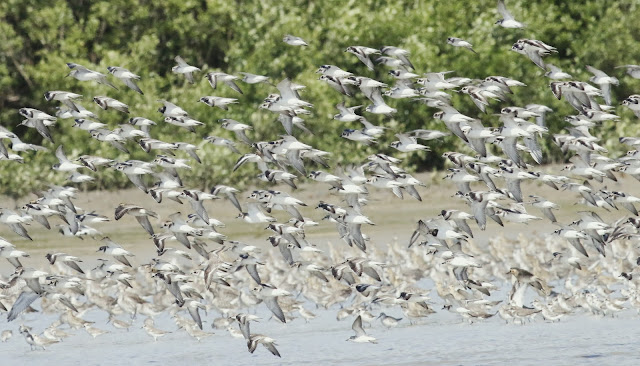We do have several IBAs in Peninsular Malaysia. One of them is the well known IBA of Teluk Air Tawar which apparently stretches almost 10km from Bagan Belat right up to the cape of Kampung Sungai Tembus. It's one of the very few places of mudflats which can hold thousands and thousands of waders every year. So this place is a category A++ IBA which we'll need to maintain and preserve.
On 26 November 2022, I joined Dr Nur Munira and her hubby Mr Nasir Azizan for a short survey of about 2 hours. Besides the thousands of waders seen, there were three important / significant findings in this survey I think. First is the discovery of a Great Knot with a Black over Yellow Flag, followed by an Asian Dowitcher in breeding plumage and a possible Bar-Tailed Godwit from the Limosa lapponica baueri subspecies.
Lets start with the Great Knot with a flag on its tibia.
We don't get to see tagged birds quite often here. So this sighting of a Great Knot with a Black over Yellow flag which is reported to have been ringed in Kamchatka, Russia can be considered a very important observation.
You can also see there's a metal ring on its right tibia.
Great Knot is a large wader with a long and strong looking bill.
I always love to photograph them in flight like this one.
Great Knot
The second important find in this survey is an Asian Dowitcher which looks like a late breeder.
Here you can clearly see the Asian Dowitcher which is still spotting its breeding plumage.
Among the hundreds of Asian Dowitchers seen in this survey, this is the only one which is having/showing breeding plumage.
A group of Asian Dowitchers foraging for food.
Here is another interesting find which if proven correct it could be one of the first official sighting of a Bar-tailed Godwit subspecies which breed as far as west Alaska.
The Bar-tailed Godwit which commonly occurred here are those from the Limosa lapponica lapponica tribe which has a whitish rump.
I believe the number of Far Eastern Curlews seen here are usually in a single digit. That is why they are quite uncommon in this region. This could also be due to the difficulty to differentiate them from the more common Eurasian Curlew unless you have a very clear comparison photo like the one below.
Eurasian Curlew (left) and a Far Eastern Curlew (right)
Meanwhile, I think this curlew could be either a female or a sub-adult Eurasian Curlew - its bill is kinda short.
Here is a small group of them (Eurasian Curlews). The one on the far right could be a Far Eastern Curlew.
Aside from rare sights of uncommon birds in TAT, what makes Dr Nur Munira and other researchers kept returning to conduct their research month by month and year by year is probably due to the reason that this location is a significant staging area and roosting place for migratory waders. Its long stretch of mudflats is an ideal place to accommodate thousands of waders each year.
Most of the species seen were Lesser Sand Plovers, Red-necked Stints and Curlew Sandpipers.
The "woosh" sound they make as they fly-by is a soothing therapy.
Once they take off, they will usually fly towards the sea.
This time we saw lots of Asian Dowitchers - hundreds of them !
Stream after stream of waders leaving the shore.
They will usually try to fly higher as they leave.
and then off they go again.
Although they will fly towards the sea, some of them will do a "U" turn and return to shore.
Here you can see a mix group of waders.
Some Asian Dowitchers show a slightly up curved bill like the one above.
and some show a shorter bill.
A group of Pacific Golden Plovers.
This is a Red Knot (the one in the middle) as pointed out for me by the more experienced birders.
Asian Dowitcher
Once they have landed we can observe them even closer.
Here is an Asian Dowitcher with a slightly upcurve bill.
The middle one is a Broad-billed Sandpiper (BBS) flanked by a Lesser Sand Plover (LSP) and a Red-necked Stint (RNS).
Here are a few Ruddy Turnstone in the back ground.
We also saw a few of them not too far off-shore like the one above.
Greater Sand Plovers
This area is usually frequented by a few Nordmann's Greenshanks but this time we only saw one.
A plain looking Broad-billed Sandpiper. They will look smarter in a few months time.
This Red-necked Stint body looks longer in person.
When in comparison, they will look smaller.
A Whiskered Tern flying above us.
TAT - ONE OF THE BEST WADERS ROOSTING SITE IN MALAYSIA !
















































No comments:
Post a Comment